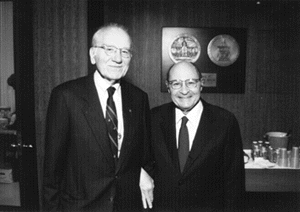|
|
Genetics Institute FormedNew enterprise honors Victor McKusick and Daniel Nathans
Office of Communications and |

Uniting nine centers, scores of physicians and scientists, and budgets worth tens of millions of dollars, the School of Medicine has announced the formation of a new institute that consolidates under a single institutional umbrella much of the genetic disease research, education and treatment enterprise now widely spread throughout Hopkins.
In naming the new institute the McKusick-Nathans Institute of Genetic Medicine, Hopkins jointly honors two pioneer faculty members, whose work in the lab and at the bedside over the past 40 years helped transform a fledgling scientific specialty into the driving force of medicine.
 |
| Victor McKusick and Daniel Nathans took center stage at a recent event announcing the formation of a new institute named in their honor. The McKusick-Nathans Institute of Genetic Medicine will consolidate nine centers under a single institutional umbrella. |
"We expect the combination of funds, facilities and multidisciplinary faculty in human and experimental genetics to form a critical mass that will attract even more talent and resources to genetic medicine," said Bart Chernow, vice dean for research and technology and acting director of the new institute. "The future of medicine is irrevocably tied to genetics and to the ability to gather and use information about genetics and the human genome. Those institutions prepared to do these things efficiently and effectively will spark an explosion in our understanding of and ability to treat the multitude of diseases related to genetic abnormalities."
Ultimately, Chernow said, the institute will have a permanent physical home--in the new research tower planned for construction on the medical campus--but it already is unusual among the few similar programs in the United States, both in the number of existing centers it unites--nine--and in the breadth of clinical and research collaborations it supports.
For example, the Center for Inherited Disease Research, which offers gene analysis and interpretation services for scientists hunting for complex disease genes, is a joint operation with the National Institutes of Health. The Online Mendelian Inheritance in Man project is an internationally known Internet-based database used globally by geneticists to share findings. The Clinical Program in Genetic Medicine integrates diagnostic, counseling, screening and treatment resources for patients with genetic disorders and for their families. And a newly approved Residency Program in Genetic Medicine will coordinate postdoctoral training in genetics.
By most accounts, medical genetics as a recognized medical specialty was developed by Hopkins' Victor A. McKusick, University Professor of Medical Genetics, for whom the institute is co-named. As a practicing cardiologist, McKusick developed a keen interest in diseases that clustered in families, prompting a systematic search for clues to their origins. He was among the first to link the unusual cardiovascular and skeletal symptoms of a known inherited disease--Marfan syndrome--with a single defective gene. He also was the first to create a published database of genetic information in people, helping to lay the groundwork for the Human Genome Project.
Daniel Nathans, a molecular geneticist long known for his work with animal virus genetics, earned a Nobel Prize in 1978 with Hopkins colleague Hamilton Smith, for using enzymes as biochemical "scissors" to cleave and thus analyze DNA. The work ushered in the genetic engineering revolution of the last two decades. More recently, Nathans received the National Medal of Science, this country's highest scientific award. From 1995 to 1996 he served as interim president of the university.
"Because of people like Drs. McKusick and Nathans, Hopkins has led the way in genetic medicine for decades and with this institute, so appropriately named for them, will continue to do so," said Edward D. Miller, dean and CEO of Johns Hopkins Medicine.
Other centers and programs to be consolidated in the new institute are the Greenberg Center for Skeletal Dysplasia, which unites research, diagnosis and care of patients with congenitally short stature; the Center for Craniofacial Development and Disorders, whose physicians investigate normal skull and facial development and the genetic events leading to malformations; the DNA Diagnostic Lab, which specializes in testing for 14 genetic conditions and their carriers; the Predoctoral Training Program in Human Genetics, which is turning out the physicians and researchers who will lead the next generation's genetic research and treatment; the Genetics Resources Core Facility, a scientific "superstore" providing biochemical reagents and other products for researchers, as well as a cell culturing, DNA analysis and research planning service.
Hopkins has a long-standing tradition of pioneering research in human genetics. Researchers here were the first to assign a gene, for the Duffy blood group, to a specific chromosome, setting off worldwide interest in gene mapping. Professor emeritus Barton Childs, who was head of Hopkins' first division to study and treat pediatric congenital disease, discovered a key rule of chromosome biology in 1963: that only one member of an X chromosome pair is active. The first idea of the variability of the gene for Huntington's chorea, a key diagnostic step, took place at Hopkins, as have many of the earliest trials of gene therapy for cystic fibrosis and gene-based vaccines for certain kidney cancers. In recent years, scientist Bert Vogelstein was the first to pinpoint genes for inherited colon cancer.
According to Chernow, funding for the institute comes from existing and expanded sources, including grants, and both private and corporate contributions.
| GO TO JANUARY 25, 1999 TABLE OF CONTENTS. |
| GO TO THE GAZETTE HOMEPAGE. |